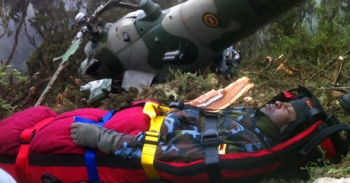Revealed: Why the UPDF choppers crashed
By Online Team
20th Aug 2012:
An unprecedented catalogue of mistakes, inexperience, bad orders from above, and a total lack of professionalism by tragic Uganda Peoples Defence Forces (UPDF) pilots have emerged as the most likely causes of the triple helicopter crashes that claimed the lives of seven Ugandan soldiers in Kenya last week.
Pilots communicated in Luganda
Contrary to well established international aviation rules and regulations, the pilots of Uganda’s three ill-fated Mi-24 attack helicopters that crashed in the Mt Kenya ranges were communicating in the local Luganda language, Kenyan newspaper The Star has reported.
“…Why were they all communicating in their vernacular when in distress yet they knew they might need assistance from the locals,” the newspaper said quoting a Kenyan military source.
Kenyan civil aviation sources told The Star that they could hear the soldiers as they communicated amongst themselves in Luganda – just minutes before the crash. Military sources said the soldiers were about 30 minutes into their flight when they realized there was bad weather ahead.
To try and compensate for the poor visibility, the pilots are alleged to have gained height and were flying far above the required altitude. Aviation experts said the choppers were flying at 11, 000 feet when they came down.
A pilot who was flying in the area told The Star that he picked on his civilian radio frequency, one of the distressed Ugandan pilots asking for instructions. They spoke in English before resorting to Luganda.
The Kenyan pilot then said that he then heard another voice instruct the pilots to increase speed to 170 knots. The rest of the instructions were delivered in vernacular.
Realising that the chopper pilots were heading straight into the mountain, the Kenyan pilot attempted to break into the military frequency to warn them of the dangers ahead but he was unable to get through.
Flying off course
It also emerged that three of the four helicopters which crashed into Mt Kenya had diverted from the flight plan they had filed with their Kenyan counterparts.
Officials at Kenya’s Department of Defence (DOD), military and civilian pilots as well as aviation experts who requested anonymity due to the sensitivity of the matter told The Star newspaper that the choppers detoured from their original flight plan which would have seen them fly north of the mountain towards their destination in Wajir.
Instead the pilots took a path which saw them fly south of the mountain leading them into thick fog and inclement weather which proved treacherous for the pilots who did not have any experience navigating the mountain.
Bad ‘orders from above’
The Star newspaper also reported that midway through their flight the soldiers received instructions from their superiors to change their route to throw off the Somali insurgents whom they suspected might know of the flight path.
“…They were avoiding overflying settled areas and because they did know the terrain and due to bad weather, they rammed straight into the mountain,” explained one of the pilots who has extensive experience in flying in the area.
Lack of experience
Aviation experts also told The Star newspaper that the fact that the four helicopters were flying in formation indicated that the lead pilot may have been the only one with the experience of negotiating the mountain. But even he was not without blame.
“…Any other pilot leading a formation would turn back if he realized that his colleagues were not with him. Why did he fly ahead to Garissa without first establishing the status of the rest of his team,” Kenya’s DOD spokesman Bogita Ongeri asked?
Seven soldiers died when one of the choppers crashed and burnt into flames while another 15 others were rescued and suffered minor or no injuries. Only one of the four newly acquired MI-17 and MI-24 helicopters landed without mishap at Garissa.
The helicopter gunships were enroute from Entebbe to Somalia where they were to join in the ongoing AMISOM operation to capture the port city of Kismayo from the Al Shabaab militia. END. Login to www.ugandacorrespondent.com every Monday to read our top stories mid-week for our updates
Follow us: Twitter: @UGCorrespondent
Follow us: Facebook: Uganda Correspondent
![]()


